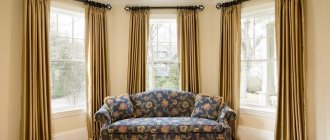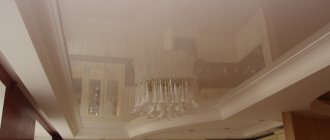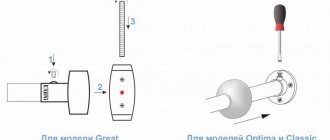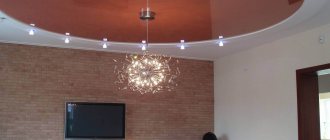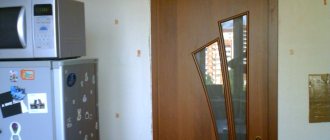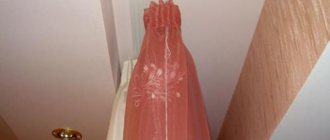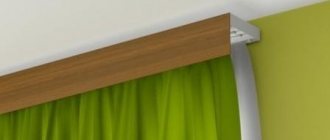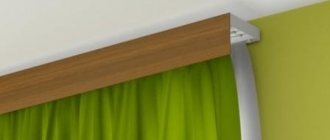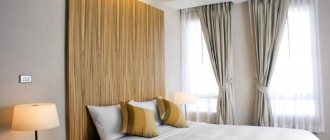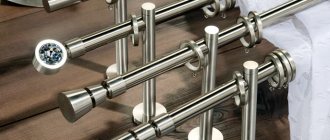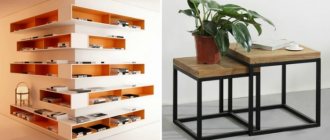One incorrectly selected detail can spoil the impression of the entire design canvas, created long and carefully. This applies to both works of art and home decoration. For example, to choose the right cornice for a suspended ceiling, photo examples from the Internet are not enough. You need to take into account your interior: the wallpaper pattern, the color scheme of the finish, and much more.
It is the harmonious combination of little things that gives the interior integrity, brightness and individuality. It is important to understand that there is no single correct answer to the question of what are the best options for attaching curtains in a room with suspended ceilings. Each time you have to solve the problem anew and with new input data.
In itself, a suspended ceiling is very practical: it is relatively inexpensive, varied in design, and easy to install. But the comparative pliability of the canvas causes some difficulties for designers - they have to somehow use more stable surfaces.
Read more: Is it worth hanging a suspended ceiling in the kitchen?
Cornices for a house with a suspended ceiling
Two types of cornice designs are used with suspended ceiling systems. Wall-mounted ones are attached directly to the walls of rooms. Their installation can be done when the blade is already secured, although preparatory drilling work can be done in advance.
With ceiling mounting everything is more complicated. It may require an embedded beam or a niche in the recess of which the cornice system will be hidden.
A hidden cornice for a suspended ceiling is more difficult to install and requires more expense, but it looks so impressive and changes the proportions of the home that the result is worth the expense.
Curtain sizes
The length of the curtain can match the size of the window opening - this is an economical option, or it can take up the entire length of the wall. The recess for the curtain (niche) must correspond to the length of the wall.
How to choose a ceiling cornice for curtains: types and design featuresCurtains for the bedroom - 135 photos of the best new products and exclusive designs. Review of unusual design options and combinations of curtains in the bedroom interior
- How to decorate curtains - useful tips and options for the best decoration ideas on 115 new photos!
Types of closed installation of cornices
The structures holding the curtains can be made invisible, then they will come out directly from the ceiling surface. Visually this increases the height of the room, giving it special beauty and charm. Moreover, you can hide both ceiling and wall versions of cornices.
You can get this effect using a niche device. To do this, an indentation is made from the wall on which the window is located. It is calculated depending on the type of model and the width of the curtains when folded, since the folds should not be wrinkled and touch the ceiling fabric with each movement.
Usually this is a distance of 10-20 centimeters to the embedded element, where the fastening of the tensioned ceiling surface ends.
Most often this is a wooden beam, but sometimes a special lightweight metal profile is used. In the resulting niche you can place any system for curtains, with a mechanical or manual method of sliding.
Colors
In well-lit, bright rooms, light curtains are also necessary. Pastel-colored curtains, such as Japanese curtains, look great against a white ceiling fabric.
Austrian curtains - the best models with interesting tailoring options in the interior + 150 photos- Sheer curtains are an option that will help keep the interior light and cozy +140 photos
Art curtains - 125 photos of modern curtains with exceptional interior design!
But we must refrain from combining the ceiling canvas with the same white walls, so that the room does not resemble a hospital.
It is better to hang curtains made of fabric that is not heavy at all to a glossy ceiling.
Bright, massive draperies in deep tones are hung with dark ceilings.
For a modern style, pleated or Roman curtains, which are now fashionable, would be very appropriate.
Tire type of curtain rods
They can be made of aluminum or plastic and represent a guide profile, like a tire with grooves arranged in it for laying stretched strings. Curtains move along them using hooks or loops.
Rail curtain rods for curtains under suspended ceilings can consist of a different number of rows:
- single-row - used when it is necessary to zone the living space or as an addition to blinds;
- double-row - the most common, suitable for daytime tulle and nighttime blackout curtains;
- three-row - used in more elegant interiors, where the third row is occupied by a lambrequin, draperies or a second night curtain that overlaps the first.
Selection of accessories
To decorate ceiling curtains, all kinds of accessories are used - tassels, eyelets, tiebacks, curtain holders and others.
When choosing these additions to curtains, you must follow certain rules:
No additional details can interfere with the overall design idea of the room;
- three-layer and two-layer compositions should not have many additional details;
- simple fabrics of not very bright colors require bright additional details.
By skillfully hanging curtains hidden under the ceiling, you can create a wonderful visual effect that transforms any room.
Such curtains create elegance and coziness in the interior, and for rooms with low ceilings, these curtains are undoubtedly the best option.
Profile cornices and their advantages
This type is the most reliable and common. Rugged aluminum or plastic construction is easy to install and durable to use.
It is a profile, straight or curved, with a guide structure along which hooks with curtains move. They can consist of several rows or be composed of several single rows.
Their weight is very light and does not create a deforming load on the ceiling or walls, especially when drywall is installed instead of plaster.
A variety of such curtain rods are flexible, which easily bend in any direction. They can be rounded at the edges or given a wavy shape just by fastening along a given line, which can be very convenient when designing unusual layouts and bay windows.
How to install?
The installation of built-in and open cornices is quite different. If you are not confident enough in your abilities, do not have suitable experience in the construction business, and if you have the opportunity to hire professionals, we strongly recommend that you contact the company. Installing a cornice is not a quick and rather painstaking task. However, it is possible to do everything yourself if you follow the instructions.
It should be repeated again that the decision to install any type of ceiling cornice is made at the planning stage of installing a stretch ceiling.
To hang an open structure, you must complete the following steps:
- Mark the future position of the cornice on the ceiling.
- Attach the fixing frame to the walls.
- Secure a wooden beam the length of the cornice, and such a thickness that it fits against the future ceiling sheet. Please note that the beam must be well processed to remove all irregularities and roughness. It is also necessary to treat it with an antiseptic solution to prevent the growth of fungi and mold.
- Stretch the ceiling. First you need to glue protective rings onto it with holes burned inside for twisting. It’s better to just burn the holes, so you’ll melt the edges.
- Screw the cornice using self-tapping screws to the beam.
Make sure that the screws fit exactly into the holes in the ceiling panel. Without securing a sufficiently fragile canvas, you risk tearing it and sending the “arrow” further across the entire surface.
To attach a niche cornice, do the following:
- Screw the cornice to the main ceiling where you have planned its location.
- Attach the beam with clamps almost close to the cornice. It should help hide the cornice, so choose the right height.
- Attach the canvas fastener to the beam and, based on the height of the fastening, tension the ceiling.
- All precautions for the beam and for the canvas are the same as for fastening an open structure.
When installing the mount on a bay window, try to choose solid bars up to each of the kinks. This way you will avoid insufficiently secure fastening of screws in the beams.
It is recommended to choose good quality solid wood beams for beams. If the quality of the board is poor, there is a possibility that it will crumble as a result and that the screws will not hold securely enough.
Be extremely careful when installing hidden curtain rods. Its edges must first be wrapped with masking tape so that when stretching the ceiling fabric they do not damage the material with sharp corners.
It is generally recommended to sharpen the edges a little so that they do not cause problems or complaints in the future.
Automatic way to control curtains
An existing mechanical system for controlling the movement of curtains can be automated if an electric motor or special sensors for combining with a remote control and telephone are built into it.
Then it will be possible to program the movement of the curtains by the clock, as well as control them using an electronic smart home program.
How to remove?
Removing a ceiling cornice is much easier than hanging it. All that is required is to unscrew the screws and remove the cornice.
If you dismantle the structure yourself, it is recommended to start unscrewing it from the sides, gradually moving towards the middle. This way you will avoid damage to the cornice itself.
When removing, you need to be extremely careful and make sure that the sharp edges of the profile do not scratch the ceiling. The least this can entail is unsightly tightening, but you can also make a hole in the ceiling, and replacing the fabric will be quite expensive.
Remember that you can only hang another cornice in the same place where the previous one hung, and you will have to fall into the same holes in the ceiling sheet. If you plan to change the cornices in the future, it is recommended to install dowels for repeated use instead of self-tapping screws.
